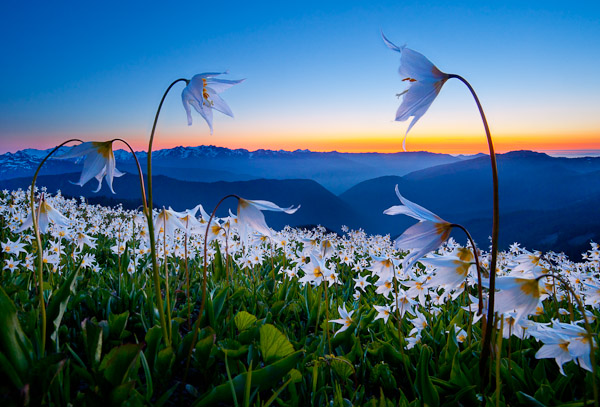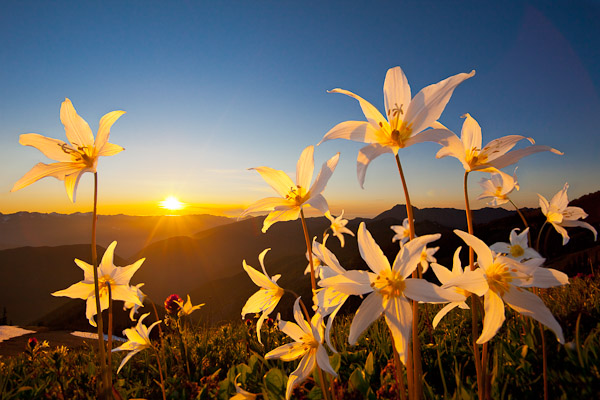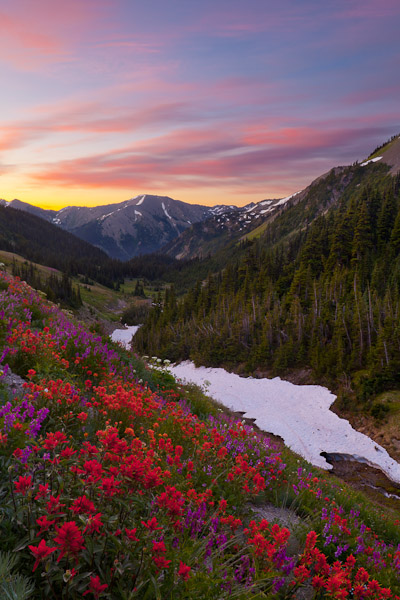Photographing Wildflowers
I reviewed some wildflower scenics from my August, 2011, Olympic National Park shoots and was once again reminded of the old carpenter maxim “measure twice, cut once”. The low cost of shooting digital removes the cost barrier to shooting, shooting, shooting. Why not make dozens of shots? Surely some will succeed. I get in this mode too sometimes, especially when the mosquitoes are biting.
A sound strategy for scenic photography involves preparation, scouting and—once you find the spot—discipline. Preparation means researching the area beforehand—tasks like internet searches and interviewing people with local knowledge. Preparation means arriving at your destination at the right time, with the right equipment and with a prevision of what’s in store. Often it means making a shot list. Scouting means footwork. A car, a kayak or your boots may get you near the grand vista, but you should explore extensively on foot to find your vision. Finally, when you find the “shot”, discipline is key.

I’ll use a few examples to illustrate scouting and discipline.
In the Northwest, August, 2011, was a wildflower photo bust at Mt. Rainier—too much snow. At Olympic National Park—where subalpine flowers usually peak in July—August was fabulous.
Example 1 Suspecting it could be good shooting after checking the Olympic NP webcams, I drove to Port Angeles and up to Hurricane Ridge, arriving in the afternoon of August 4th. Wildflowers were blooming all along the serpentine roadway approaching Hurricane Ridge. In full scouting mode, I stopped at favorable pullouts, often walking both sides of the road, looking for the “shot”, making mental notes of some remarkably extravagant spots. Favorite wildflowers like Crimson Columbine, Columbia Lily and Indian Paintbrush had starring roles. I then drove up the road and checked Hurricane Ridge—walking the parking lot perimeter and some of the paved trails. I surveyed the lupine for portraits and for scenics with mountain backdrops. I scanned for fawns amongst the browsing deer. It was overcast skies—there would be no warm, evening light on the deer—but it was good portrait light. I decided the “shot” was back down the road, where Columbia Lily not visible from the car were blooming profusely. I hopped in the car, drove down the road and parked across from the most promising site scouted earlier.
The cool damp July had fueled the late bloom: one Columbia Lily sprouted twenty-one individual flowers! The spot was a treasure trove of reds, blues and golds. I mounted a 300mm f/4 on my Canon 5D II, and walked the road edge, framing shot after shot through the viewfinder, but taking no pictures. I found the backgrounds busy, or I was unable to get close because of the steep bank. I returned to the car and switched to my 500mm f/4, adding a 25mm extension tube for closer focusing. The 500mm pulled the flowers closer, with great background “bokeh”. I kept searching, handheld, looking again and again through the viewfinder at some of the more promising flowers; trying to line up distant color behind them. Finally I found it. I marked the spot mentally, set up the tripod and made a few captures. The one at left was probably my favorite.
Before leaving the park, a Ranger informed me that Obstruction Point Road—still closed—would open in a few days. If you don’t know Obstruction Point Road, it’s a rough, dusty, dirt and gravel gear grinder that leads from Hurricane Ridge east about ten miles to Obstruction Point, where trailheads diverge to Lillian Ridge, Grand Valley and Badger Valley. A drive on this road ensures a dust-laden car, and maybe a new rattle. Because it’s in the rain shadow of the Olympic peaks, the area is relatively dry, with expanses of subalpine meadow. In a good year the roadside wildflower shooting—both for portraits and scenics—can be amazing; hiking for wildflower scenics can be fabulous as well.

A week later, I’m back. I check the roadsides again along the paved Hurricane Ridge road but those flowers are mostly past peak. No worries, Obstruction Point Road is open, and I head out on the dirt roadway to an unending display of summer wildflower glory. I’m in scouting mode and loving it. There are still plenty of snow patches, with frequent, vast fields of Avalanche or Glacier Lilies. Lupine and Paintbrush clump here and there—not yet peaking. I find the best Rockslide Larkspur I’ve ever seen—a field of deep, deep blue—but I pass it by dreaming of better things ahead. At road end, I hike down into Badger Valley to discover that the Paintbrush and Western Sweetbroom look good but peak bloom is maybe a week away. Badger Valley displays many flowers particularly well; Glacier Lily, Elephant Head, Bog Orchid, Cow Parsnips, Crimson Columbine—and many, many more. Only the Asters and Daisies are no-shows. I take no pictures, but I vow to return.
Example 2 For sunset, I’m back on Obstruction Point Road, where I’ve already probed an expansive field of Avalanche Lily. It’s time now to go deeper. I look for pairs or trios of fresh flowers on tall stems that front a promising patch. I’m hoping to put the little lilies up into the sky, which means getting really, really low. Camera off tripod, I switch to Live View and hold the camera almost at ground level (A right-angle finder could be useful here, but with Live View, a right-angle finder is a less needed tool). I slowly move the camera to-and-fro; it looks like I’ve beamed down into “A Bugs Life”. Finally, I find the exact spot I want to set the tripod, but quickly realize I can’t get the tripod low enough without getting a leg downslope and hence in the shot. No problem, I have my Gorilla Pod in hand, and I mount the camera directly to it, place it behind the flowers, and twist and crank the pod legs until I find again my pleasing composition. I take a few exposures using a cable release (Canon TC80-N3) and auto-exposure bracketing, focusing on the foreground flowers, then a few more focusing on the background. I’ll combine them in Photoshop if they still look promising when I get home.

Example 3 The next week finds me back at Olympic NP once more, again along Obstruction Point Road. Lasts week’s Larkspur have largely gone by, as have much of the Avalanche Lilies. It’s now August 17th, and many areas of Lupine and Paintbrush just aren’t going to get going. I walk the road and a couple of ridges, burning time usefully scouting on a sunny afternoon. I find a promising set of Avalanche Lilies that are facing—remarkably—away from the sunset, which will mean towards the camera. The direct sunlight is harsh at the moment, so I move on—looking, looking, looking. My traverses don’t find anything better, so just before sunset, I return to photograph the Avalanche Lilies. I again use the Gorilla Pod and Live View on the Canon 5D, and focus twice—once for foreground and once for background. It’s breezy, so I also limit the depth-of-field a bit and up the ISO to 400. The flower groupings work out really well compositionally. All that searching has again paid off.

Example 4 The next morning before dawn, I’m at the trailhead at the end of Obstruction Point Road. The sunrise has promising clouds, so I debate what to do: go up high on Lillian Ridge for a fabulous sunrise, or descend into Badger Valley, like I planned? Badger Valley will yield a less dramatic sky—because I’ll be down in the valley—but has the promise of an extravagant flower foreground. I stick with the Badger Valley plan. It’s about 20 minutes, mostly down switchbacks on a scree slope, to where the Paintbrush and Sweetbroom are lush and abundant. When I arrive I set up behind the flowers, and—following my regimen—glue my eye to the viewfinder and squat down, moving side- to-side, up-down, and then aah, here it is!—a red-with-Paintbrush foreground looking down valley. I mark the exact spot mentally, and set up the tripod as the clouds pink up. I frame and take several exposures, for foreground and sky, to combine later in Photoshop.
Whew! I hope I didn’t get too long-winded: all that looking, looking, looking. Just remember—look thrice, shoot once.
Gary